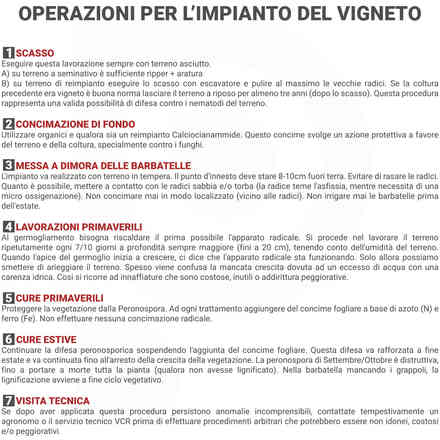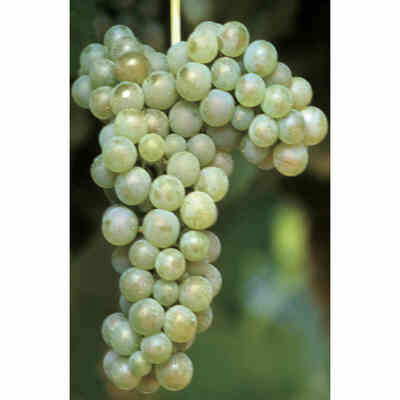Matilde (10 pieces)
Description
 AUTHORIZED RETAILER
AUTHORIZED RETAILER
MATILDE (10 pieces)
Rootsotcks: 1103P - K5BB - S04 - 140RU - 420A (We will send the graft carrier available at the moment)
Obtained by Prof. Manzo in 1962 at the Istituto Sperimentale per la Frutticoltura in Rome from a cross of Italia x Cardinal.
- Ampelographic characteristics: bud with expanded apex, green, glabrous, apical leaflets unfolded, shiny green with bronze shades. Leaves are medium-sized, pentagonal-long with prominent lobes, smooth, slightly wavy, glabrous. Open lyre-shaped petiolar sinus. Cluster: medium-large, cylindrical-conical, often elongated, winged, fairly spreading. Berry rather large, ovoid; firm flesh with slightly aromatic flavour; relatively thin, resistant, yellow skin.Sprouting time: medium-early.
- Ripening time: medium.
- Vigour: good.
- Real fertility: 1.80.
- Production: medium-high.
- Cluster weight: 600-800 g.
- Berry weight: 6-7 g.
- Grape seeds: 2 per berry.
- Sugar content: 14-15%.
- Total acidity: 4-5‰.
- PH: 3.43.
- Resistance to transport: excellent.
- Training and pruning: prefers expanded training systems and medium pruning.
- Sensitivity to disease and adversity: normally resistant to disease; in cold and humid springs and in fertile soils it can give rise to coulure and millerandage.
- Overall assessment: excellent for its earliness, cluster appearance and fine muscat aroma.
Clones in multiplication: Matilde VCR15: clone selected for its high fertility, absence of millerandage and excellent productivity. The consistent skin and high detachment index increase its resistance to transport and cold storage.
CULTIVATED AREA IN ITALY
YEAR 1990 2000 2010
HECTARES - 888 617
RULES TO PLANT A VINEYARD
1. PLOW
You must perform this operation always with dry soil
A) On arable land is generally sufficient to ripper + to plow
B) On planting soil is generally sufficient to plow with an escavator and to clean the old roots.
If the previous crop was a vineyard, it is a good idea to leave the soil fallow for at least three years (after plowing). This procedure represents a valid possibility of defence against soil nematodes.
2. SOIL FERTILIZATION
Use organics and if it is a reimplantation, use Calciumocyanamide.
This fertiliser has a protective effect on the soil and the crop, especially against fungi.
3.PROPAGATING GRAPE VINE CUTTINGS
The planting should be carried out in temperate soil. The grafting point should be 8-10 cm above ground. Avoid shaving the redices. As much as possible, put sand and/or peat in contact with the roots (the root fears asphyxiation, while it needs a micro-oxygenation). Never fertilize in a localized manner (near the roots). Never water the rooted cuttings before summer.
4.SPRING WORKS
When sprouting, the root apparatus must be heated as soon as possible. Work the soil repeatedly every 7/10 days at increasing depth (up to 20 cm), taking into account the moisture of the soil. When the apex of the bud starts to grow, it means that the root system is functioning. Only then can we stop watering the soil. Failure to grow due to access to water is often confused with a lack of water. This is why watering is used which is expensive, useless or even worse.
5.SPRING CURE
Protect vegetation from Peronospora. To each treatment add nitrogen (N) and iron (Fe) foliar fertilizer. Do not make any radical fertilization.
6.SUMMER CURE
Continue with the defense against Peronospora by suspending the addition of the foliar fertilizer. This defense should be reinforced in late summer and should be continued until vegetation growth stops.
The September/October blight is destructive, to the point of bringing death to the whole plant (if it has not lignified). The rooted vine lacks clusters, so lignification occurs at the end of the vegetative cycle.
7.TECHNICAL VISIT
If incomprehensible anomalies persist after this procedure, contact an agronomist or the VCR Technical Service promptly before carrying out arbitrary procedures which may be unsuitable, expensive and/or worsening.





























